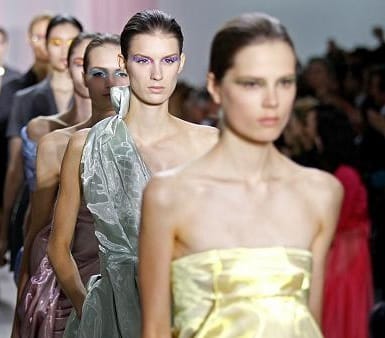
Eating disorders are a widely known problem today. Body standards and self-images are very important to many people. It is common for models to develop eating disorders because it is part of their job to keep a slim figure.
Some argue that the fashion industry is a possible cause of this. The fashion industry can be viewed as a cause of eating disorders because of the pressure put on the models, harmful weight-loss methods used, and photographs that promote eating disorders.
Eating disorders are continuous abnormal eating habits that negatively impact a person’s physical and mental health. They are both diagnosable and treatable. Common eating disorders are anorexia nervosa, bulimia nervosa, binge eating disorder, and more.
Carrie Arnold explains that, “[m]any men and women are unhappy with their bodies and are on a diet. People with eating disorders also often express extreme body dysmorphia [bad body image] and restrict their food intake.”
Those who have eating disorders are likely to become dangerously underweight without treatment. The fashion industry may be one of the many causes of eating disorders. Models in the fashion industry are generally very thin.
Eating disorders are a prevailing condition today because of the stress of being thin and living up to society’s standards.
The pressure on models to maintain a certain weight is preposterous. Models in the fashion industry are required to have a specific body shape and size to model the clothing. The article, The Fashion Industry Glamorizes Anorexia, states, “[t]he pressure to be thin comes from all sides—editors, stylists, hairdressers, even boutique owners who refuse to stock sizes above
8… Natalia Vodianova, a 24-year-old Russian model… explained how industry pressure caused her weight to plunge to 106 pounds when she began losing her hair.
With the help of a doctor, she regained her health, only to hear designers complain about how her body had changed” (Moore). The demand of having an extremely thin body from designers, editors, and more has caused models to lose a perilous amount of weight.
Protests are made about their body changes, despite the health they recover. Maintaining a healthy weight is a hardship when the ‘desired’ weight and body image is unhealthy.
Not only does the fashion industry command slimness, but they also encourage and use unhealthy weight loss methods. Because the weight requirements are so strict, the fashion industry resorts to extreme measures to meet their expectations.
Lisa Hilton reports, “[a] survey published by the U.S. National Library of Medicine lists a range of weight-loss methods… that would make any model agency proud— 69 percent skip meals, 34 percent use diuretics, 67 percent sweat off the pounds in the sauna, 30 percent regularly vomit and 40 percent use laxatives.” Shocking percentages were found of unsafe methods used.
The fashion industry praises these methods that either are an eating disorder or can lead to developing one.
Opponents may argue that photographs on media cannot cause or promote eating disorders. It is believed that images can not affect your health or eating patterns. Carrie Arnold contends that, “I think I know what they’re getting at—that looking at these images makes you more likely to develop anorexia—but there’s no actual evidence that this is true.”
However, there are scenarios where images have been used as encouragement to becoming thinner. This would not be a problem if it was a healthy amount of weight, but that is not the case.
Libby Rodenbough discovered that, “[i]n 2007, [Isabelle] Caro had appeared in ‘No Anorexia,’ an ad campaign by provocative fashion photographer Oliviero Toscani… The campaign… sparked controversy, in part because some pro-anorexia and -bulimia websites used its ads as ‘thinspiration’ (collections of images or videos of slim to skeletal women used by those suffering from eating disorders for weight-loss motivation).”
Although the intentions of the campaign were contradicted, the outcome was still negative. It was used to inspire losing weight, brightening an unhealthy body image standard. An image is possible of affecting a person’s self-image and eating habits.
Overall, the fashion industry can be seen as a cause of eating disorders. The oppression they have on models forces a slim weight that can be unhealthy. To achieve this slim weight, a series of dangerous weight-loss methods are used and encouraged.
The question is no longer if the fashion industry is a possible cause of eating disorders, it is whether or not the effects can be reversed.
Would it be enough if models were to regain healthy body weight and the fashion industry incorporated more bodyweight ranges throughout their models? Or will the cycle continue?
Works Cited
Arnold, Carrie. “Altered Fashion Magazine Photographs Do Not Cause Eating Disorders.” The Culture of Beauty,edited by Louise I. Gerdes, Greenhaven Press, 2013. OpposingViewpoints. Opposing Viewpoints in Context.
Hilton, Lisa. “The Fashion Industry Should Not Be Held Responsible for Eating Disorders.” Eating Disorders,edited by Roman Espejo, Greenhaven Press, 2012. OpposingViewpoints. Opposing Viewpoints in Context.
Moore, Booth. “The Fashion Industry Glamorizes Anorexia.” Anorexia,edited by Stefan Kiesbye, Greenhaven Press, 2010. At Issue. Opposing Viewpoints in Context.
Rodenbough, Libby. “The Fashion Industry Promotes Eating Disorders.” The Culture of Beauty, edited by Louise I. Gerdes, Greenhaven Press, 2013. Opposing Viewpoints. Opposing Viewpoints in Context.

when was this written?